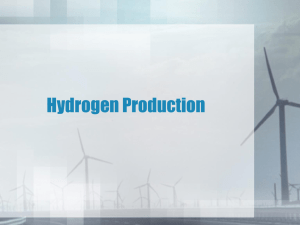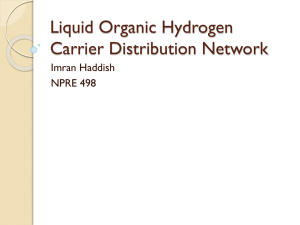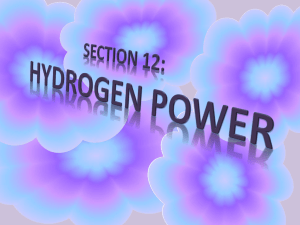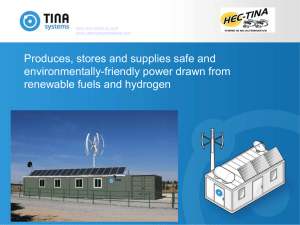09-31705357 Biohydrogen as Future Energy Source
advertisement
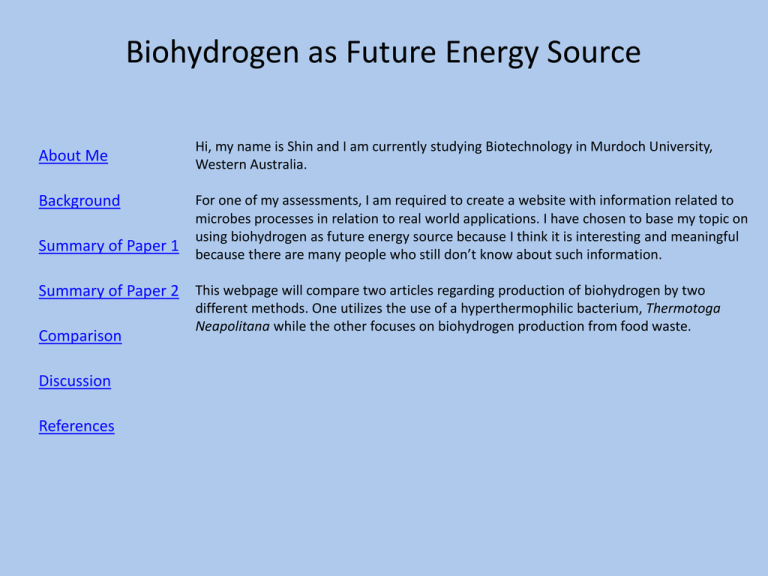
Biohydrogen as Future Energy Source About Me Background Summary of Paper 1 Hi, my name is Shin and I am currently studying Biotechnology in Murdoch University, Western Australia. For one of my assessments, I am required to create a website with information related to microbes processes in relation to real world applications. I have chosen to base my topic on using biohydrogen as future energy source because I think it is interesting and meaningful because there are many people who still don’t know about such information. Summary of Paper 2 This webpage will compare two articles regarding production of biohydrogen by two Comparison Discussion References different methods. One utilizes the use of a hyperthermophilic bacterium, Thermotoga Neapolitana while the other focuses on biohydrogen production from food waste. Background • About Me • Background • Summary of Paper 1 • Summary of Paper 2 • Comparison • Discussion • References The need for energy has been growing exponentially for the last century. While fossil fuels are depleting in a rapid rate, scientists have suggested the use of hydrogen as the fuel of the future. The field of biohydrogen had become a promising area of research. What is biohydrogen? Biohydrogen refers to hydrogen produced biologically, typically by algae, bacteria and archae. For more information, check out Biohydrogen (wikipedia). Why Hydrogen? Hydrogen is widely abundant, it has high energy content and can be produced from renewable feedstocks. (Nguyen, 2008) Unlike burning fossil fuels, in its purest form, hydrogen produces water instead of greenhouse gas when combusted and releases no greenhouse gas and produces no pollution. (Johnston, 2005) Ways to generate biohydrogen Hydrogen is not a primary source of energy, thus must be manufactured. Several ways to generate hydrogen include: 1) Photosynthetic unicellular organisms that utilize either nitrogenase or dehydorogenase reactions to produce hydrogen 2) Fermentative bacteria that produce hydrogen anaerobically 3) Various stepwise processes in which a combination of bacteria of one population predigests more complex organic molecules to make less complex feedstock of simple organic molecules that can be subsequently used by hydrogen-producing organisms. Summary of Paper 1 • About Me • Background • Summary of Paper 1 • Summary of Paper 2 • Comparison • Discussion • References Van Ooteghem, S. A., Beer, S. K., & Yue, P. C. (2002). Hydrogen production by the thermophilic bacterium Thermotoga neapolitana. In Biotechnology for Fuels and Chemicals (pp. 177-189). Humana Press. “Thermotogales is an order composed of rod-shaped, gram-negative, non-sporulating bacteria that have a loose surrounding membrane or “toga”.” (Van Ootenghem et al, 2002) Van Ooteghem et al. explored the potential of Thermotogales order, particularly focusing on optimizing thermotoga neapolitana due to its robust and adaptive nature in varying environment. Unlike earlier experiments which dealt with Thermotoga neapolitana strictly In anaerobic environment, Van Ootenghem et al. found that the species was able to utilize reduced levels of oxygen and generating hydrogen as endproduct, thus a “microaerophile”. Van Ootegham et al. also suggested that by providing low levels of oxygen, Thermotoga neapolitana are able to shift its metabolic behaviour to a more energy efficient catabolic pattern which in turn produces greater hydrogen and generates greater metabolic efficiency compared to those grown under anaerobic condition. Next Summary of Paper 1 (Part 2) • About Me • Background • Summary of Paper 1 • Summary of Paper 2 • Comparison • Discussion • References Next Summary of Paper 1 (Part 3) • About Me • Background • Summary of Paper 1 • Summary of Paper 2 • Comparison • Discussion • References Summary of Paper 2 • About Me Han, S. K., & Shin, H. S. (2004). Biohydrogen production by anaerobic fermentation of food waste. International Journal of Hydrogen Energy, 29(6), 569-577. Fermentation of food waste occur at different rate because of the different characteristics of different food components. Dilution Rate (D) is the tool that is used to control the optimum condition of such process. • Background • Summary of Paper 1 Han and Shin attempted to optimize biohydrogen production by anaerobic fermentation of food waste by altering different factors such as pH and D. • • Summary of Paper 2 At optimum D, the highest productivity achieved by Han and Shin was 70.8%, by Comparison • Discussion • References converting converts chemical oxygen demand (COD) to hydrogen (19.3%), volatile fatty acid (36.5%) and ethanol (15%). It was found that under the optimal D, it could lead the to favor microbial growth (hydrogen production) and delay the shift of predominant metabolic flow from hydrogen and acid-forming pathway to solvent-forming pathway. Han and Shin concluded that a two-stage processes would provide the preferred environments for acidogenic hydrogenesis and methanogenesis. More studies are yet to be done to further improvise the process. Summary of Paper 2 (Part 2) • About Me • Background • Summary of Paper 1 • Summary of Paper 2 • Comparison • Discussion • References Fig.2. The effect of initial D on VFA, pH and hydrogen production during hydrogen fermentation of food waste. Comparison between two articles Two articles explored two different methods of biohydrogen production. • • About Me Background • Summary of Paper 1 • Summary of Paper 2 • Comparison • Discussion • References Both methods are proven to be effective in producing hydrogen under the right condition. Paper 1 focused on production of biohydrogen through fermentation by hyperthermophilic bacteria. Paper 2 focused on production of biohydrogen through fermentation of food waste. Highest productivity efficiency achieved using thermatogales is 71% while fermentation of food waste achieved 70.8%. Both methods have similar productivity efficiency when used under optimum conditions. Discussion & Comments • About Me • Background • Summary of Paper 1 Although productivity efficiency are similar for both methods, I believe production of biohydrogen by fermentation of food waste is more ecological as it not only generates biohydrogen but also utilizes waste materials which had been increasing in the past 10 years. By devising a effective system, we could not only produce substantial amount of biohydrogen but also tackle issues regarding waste materials. It is also important to note that generation of biohydrogen through Thermotoga • Summary of Paper 2 • Comparison Both methods are inexpensive and effective in its productivity. • Discussion Many researches are now being done on improvising ways to generate biohydrogen. • References Neapolitana provide important advantages as it reduces chances of contamination and cost for cooling. References • About Me Han, S. K., & Shin, H. S. (2004). Biohydrogen production by anaerobic fermentation of food waste. International Journal of Hydrogen Energy, 29(6), 569-577. • Background • Summary of Paper 1 21st century. Technovation, 25(6), 569-585. • Summary of Paper 2 Nguyen, T. A. D., Pyo Kim, J., Sun Kim, M., Kwan Oh, Y., & Sim, S. J. (2008). Johnston, B., Mayo, M. C., & Khare, A. (2005). Hydrogen: the energy source for the • Comparison • Discussion • References Optimization of hydrogen production by hyperthermophilic eubacteria, Thermotoga maritima</i> and< i> Thermotoga neapolitana in batch fermentation. International Journal of Hydrogen Energy, 33(5), 1483-1488. Van Ooteghem, S. A., Beer, S. K., & Yue, P. C. (2002). Hydrogen production by the thermophilic bacterium Thermotoga neapolitana. In Biotechnology for Fuels and Chemicals (pp. 177-189). Humana Press.

